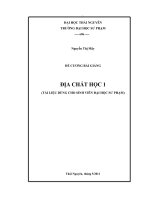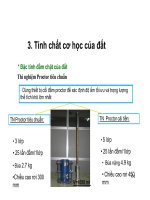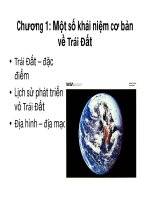bài giảng địa chất thủy văn
Bạn đang xem bản rút gọn của tài liệu. Xem và tải ngay bản đầy đủ của tài liệu tại đây (4.43 MB, 59 trang )
CHƯƠNG III
NƯỚC NGẦM
•
Đònh nghóa: là loại nước trọng lực dưới đất ở trong
tầng chứa nước thứ nhất kể từ trên mặt đất xuống.
Water Quantity-Porosity
The fraction of the volume of a rock or sediment
that is open space.
(volume of pores)/(total volume)
more porous
less porous
Porosity of sediment and rocks
Lithification reduces porosity
Sand and gravel (well sorted) - 25 - 50%
Sand and gravel (mixed) - 22 - 35%
Sandstone or conglomerate - 5 to 30%
Mud (clay) – 33-60%
Shale - < 10%
Igneous and metamorphic rocks: very low,
unless fractured
Water Quantity-Permeability
Measure of ease of
water flow
dependent on porosity &
connectivity of pores
Sand, sandstone: high
porosity and high permeability
Clay: high porosity, very
low permeability
Permeability
Fractures also important for permeability: connects
pores
Flow of groundwater
• Groundwater moves only if sufficient pressure, or head, is available to
force water through the spaces between porous aquifer materials.
• Rate of movement is determined by the hydraulic gradient, and how
well pores are interconnected. The hydraulic gradient, or slope of the
water surface between two points in an aquifer, and the aquifer
material determines how rapidly water moves from one location to
another.
• Groundwater moves from high water surface elevations (high pressure
or head) to low water surface elevations (low pressure or head).
• Water flows more rapidly where large differences exist in water
surface elevations (steep hydraulic gradients).
• Groundwater may move toward or away from streams or lakes,
depending on the hydraulic gradient.
• As groundwater moves it may be removed by a pumping well, or it
may be discharged to the earth's surface as a spring, a lake or stream.
Flow of groundwater
• Groundwater moves from
areas of recharge (often
highlands) to areas of
discharge (often lowlands)
• Unconfined and confined
aquifers are separated by a
unit of low permeability
(e.g., clay)
•
Phạm vi phân bố của nước ngầm phụ thuộc vào
điều kiện đòa lý tự nhiên, điều kiện đòa hình, đòa mạo,
đòa chất của khu vực.
Theo điều kiện thế nằm:
- Dòng ngầm
Bồn ngầm
-- Dòng bồn ngầm hỗn hợp
•
•-
DOØNG NGAÀM
• - BOÀN NGAÀM
DOỉNG BON NGAM HON HễẽP
Nước ngầm vận động dưới tác dụng của độ chênh mực nước
(chảy từ mực nước cao đến mực nước thấp).
•
Nước ngầm thường chứa trong trầm tích bở rời như aluvi,
proluvi hoặc trong các dãi cát, đụn cát ven biển.
•
•
MAËT NÖÔÙC NGAÀM
Depth to saturated zone
Often slopes toward stream or lakes
Often mimics land surface









